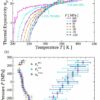Microscopic chasms forming a sea of conical jagged peaks stipple the surface of a material called black silicon. While it’s commonly found in solar cell tech, black silicon also moonlights as a tool for studying the physics of how water droplets behave.
Black silicon is a superhydrophobic material, meaning it repels water. Due to water’s unique surface tension properties, droplets glide across textured materials like black silicon by riding on a thin air-film gap trapped beneath. This works great when the droplets move slowly—they slip and slide without a hitch.
But when the droplet moves faster, some unknown force seems to tug on its underbelly. This has stumped physicists, but now a team of researchers from Aalto University and ESPCI Paris have an explanation, and they’ve got the numbers to back it up.
Aalto University Assistant Professor Matilda Backholm is the first author of the paper that details these findings, published on April 15 in the Proceedings of the National Academy of Sciences. She conducted this during her time as a postdoctoral researcher in Professor Robin Ras’s Soft Matter and Wetting group in the Department of Applied Physics.
“When observing water-surface interactions, there are typically three forces at play: contact-line friction, viscous losses, and air resistance. However, there is a fourth force that arises from the movement of droplets on highly slippery surfaces like black silicon. This movement actually creates a shearing effect on the air trapped beneath, resulting in a drag-like force on the droplet itself. This shearing force has never been explained before, and we are the first to identify it,” Backholm says.
The complex interactions of fluid and soft matter physics prove challenging to simplify into cut-and-dried formulae. But Backholm has managed to develop a technology to measure these tiny forces, explain how the force works, and finally provide the solution for eliminating the drag force altogether.
Air-shearing effect
Creating better superhydrophobic surfaces would make the world’s transportation systems more aerodynamic, medical devices more sterile, and generally improve the slipperiness of anything requiring a liquid-repellent surface.

Assistant Physics Professor Matilda Backholm’s unique micropipette force sensor technology probes the tiny forces acting between a superhydrophobic material and a water droplet. © Matilda Backholm/Aalto University
Black silicon exploits the specific surface tension of water to minimize the contact between the droplet and the surface. Cones etched onto the substrate make the water droplets glide on an air-film gap, known as a plastron. But in a counterintuitive twist, the very mechanism that enables hydrophobic surfaces to deflect water droplets also leads to the shearing effect outlined in Backholm’s paper.
“The field has been making these ultra slippery surfaces by reducing the length scale of the cones to make them smaller and more plentiful. But no one has stopped to realize, ‘Hey, we’re actually working against ourselves here.’ In actuality, etching shorter cones onto the black silicon surface leads to a greater air-shearing effect,” Backholm says.
Other researchers have noted the existence of this force but have not been able to explain it. Backholm’s findings prompt a reconsideration of the way that ultra slippery surfaces are designed. Her team’s workaround was to add taller cones with textured caps onto the black silicon surface to further minimize the total contact surface area of the droplets.
“This work builds upon the wealth of expertise from the Soft Matter and Wetting research group on the subject of superhydrophobic surfaces. Rarely does the opportunity emerge to fully explain the subtleties of the microscopic forces involved in wetting dynamics, but this paper accomplishes just that,” says Ras.
Specialized technique
Backholm adapted a unique micropipette measurement technique to gauge the forces acting against the water droplets. She is an expert on these micropipette force sensors, having used them to measure the growth dynamics of plant roots, the swimming behavior of mesoscopic shrimp swarms, and now in observing the forces in moving water droplets.
Through arduous fine-tuning, she was able to use this technique to make the breakthrough in identifying the shearing effect. Backholm oscillated the droplet and probe to detect the subtle forces tugging beneath.
“We have also ruled out the possibility that there are any other forces at play at the contact line by running these same tests on carbonated droplets. Those droplets constantly off-gas carbon dioxide, causing them to levitate slightly above the surfaces they sit on. Even still, the shearing effect was measured at certain velocities, ultimately confirming that this force acts independently of its contact with the black silicon surface,” Backholm says.
Backholm expects these findings will further enable physicists and engineers to develop hydrophobic surfaces with better performance.
More information:
Matilda Backholm et al, Toward vanishing droplet friction on repellent surfaces, Proceedings of the National Academy of Sciences (2024). DOI: 10.1073/pnas.2315214121
Citation:
Physicists explain, and eliminate, unknown force dragging against water droplets on superhydrophobic surfaces (2024, April 16)



